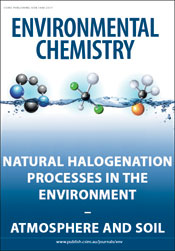
Environmental Chemistry
Volume 12 Number 4 2015
Naturally Produced Organohalogens – Atmosphere and Soil
EN14240Iron-catalysed oxidation and halogenation of organic matter in nature
Environmental context. Natural organohalogens produced in and released from soils are of utmost importance for ozone depletion in the stratosphere. Formation mechanisms of natural organohalogens are reviewed with particular attention to recent advances in biomimetic chemistry as well as in radical-based Fenton chemistry. Iron-catalysed oxidation in biotic and abiotic systems converts organic matter in nature to organohalogens.
Environmental context. The general perception that nature does not produce compounds containing halogens – chlorine, bromine, iodine and fluorine – is now known to be erroneous. Modern isolation and identification techniques have led to the discovery of more than 5000 halogen-containing compounds from myriad marine and terrestrial plant and animal sources. Many of these compounds possess extraordinary biological activity, including anticancer, antiviral and antibacterial activity of potential human benefit.
EN14202Halogenated hydrocarbon formation in a moderately acidic salt lake in Western Australia – role of abiotic and biotic processes
Environmental context. Volatile halogenated organic compounds (VOX) contribute to ozone depletion and global warming. Here we demonstrate that acidic salt lake sediments in Western Australia contribute to the global natural emission of these compounds and that the emissions are primarily of biotic origin. Elucidating major sources and sinks of VOX is a key task in environmental chemistry because their formation and degradation have major effects on atmospheric chemistry and thus earth climate.
EN14207Thermolytic degradation of methylmethionine and implications for its role in DMS and MeCl formation in hypersaline environments
Environmental context. Methyl chloride and dimethyl sulfide are important atmospheric trace gases, but their biogeochemical contributions to the atmosphere are not fully understood. The amino acid derivative methyl methionine has been hypothesised to be a precursor of these two atmospheric gases, especially in drying salt-lake environments. We found methyl chloride and dimethyl sulfide in salt crystals and soils samples of hypersaline lakes, suggesting that a thermal decay of methyl methionine could be one of the formation mechanisms responsible.
EN14208Seasonal changes in chlorine and methoxyl content of leaves of deciduous trees and their impact on release of chloromethane and methanol at elevated temperatures
Environmental context. Chloromethane is the most abundant naturally produced chlorine-containing organic compound, responsible for ~16 % of chlorine-catalysed stratospheric ozone destruction. A significant source of this gas is emission from biomass by reaction between chloride ion and methoxyl groups of the biopolymers pectin and lignin. The seasonal changes in the chlorine and methoxyl pools observed in leaves of several deciduous tree species have implications for understanding chlorine volatilisation during biomass burning and estimation of the global chloromethane budget.
EN14224Vertical distribution of BrO in the boundary layer at the Dead Sea
Environmental context. Reactive halogen species affect chemical processes in the troposphere in many ways. The reactive bromine species bromine monoxide (BrO) is found in high concentrations at the Dead Sea, but processes for its formation and its spatial distribution are largely unknown. Information on the vertical distribution of BrO at the Dead Sea obtained in this work may give insight into the processes leading to BrO release and its consequences.
EN14279Iron(III)-induced activation of chloride from artificial sea-salt aerosol
Environmental context. Inorganic, natural aerosols (sea-salt, mineral dust, glacial flour) and contributions of anthropogenic components (fly ash, dust from steel production and processing, etc.) contain iron that can be dissolved as FeIII in saline media. This study investigates photochemical processes in clouds and aerosols producing gas-phase Cl as a function of salt- and gas-phase composition employing a simulation chamber. Atomic Cl may contribute to the oxidative capacity of the troposphere, and our findings imply local sources.
EN14279 Abstract | EN14279 Full Text | EN14279PDF (1.2 MB) | EN14279Supplementary Material (804 KB) Open Access Article
EN14226Consumption of reactive halogen species from sea-salt aerosol by secondary organic aerosol: slowing down the bromine explosion
Environmental context. Secondary organic aerosols together with sea-salt aerosols are a major contribution to global aerosols and influence the release of reactive halogens, which affect air quality and human health. In this study, the loss of reactive halogen species from simulated salt aerosols due to three different types of secondary organic aerosols was quantified in chamber experiments and investigated with the help of a numerical model. The loss rate can be included into chemistry models of the atmosphere and help to quantify the halogen budget in nature.
EN14225New particle formation above a simulated salt lake in aerosol chamber experiments
Environmental context. Deforestation in Western Australia beginning in the mid-19th century led to a considerable change of the land surface, and Western Australia is now suffering more often from droughts. Particle formation induced by salt lakes has been identified as a potential control factor for changed precipitation patterns. This study aims to determine key factors involved in the particle formation process by simulating a simplified salt lake in an aerosol chamber in the laboratory.
EN14210Isotopic composition of polyhalomethanes from marine macrophytes – systematic effects of the halogen substituents on isotopic composition
Environmental context. Once released to the atmosphere, halocarbons are involved in key chemical reactions. Stable carbon isotope measurements of halocarbons can provide valuable information on their sources and fate in the atmosphere. Here, we report δ13C values of 13 polyhalomethanes released from brown algae, which may provide a basis for inferring their sources and fate in future studies.
EN14204Dynamics of halocarbons in coastal surface waters during short term mesocosm experiments
Environmental context. Halocarbons are trace gases important in atmospheric ozone chemistry whose biogenic production – among other factors – depends on light-induced stress of marine algae. Several studies have confirmed this effect in laboratory experiments but knowledge in natural systems remains sparse. In mesocosm experiments, which are a link between field and laboratory studies, we observed that the influence of natural levels of ultraviolet radiation on halocarbon dynamics in the marine surface waters was either insignificant or concealed by the complex interactions in the natural systems.



